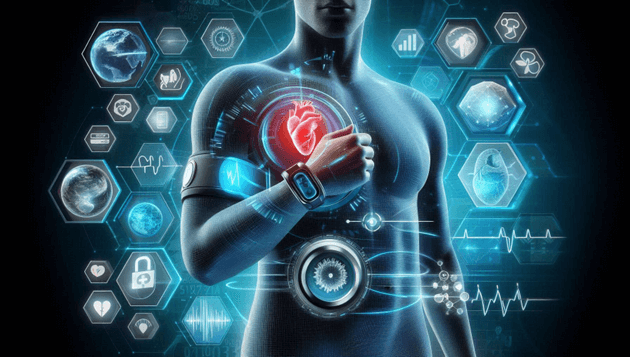How Wearable Medical Devices Are Revolutionizing Healthcare Monitoring
Published Date: 12 Oct 2024
Conventionally, the popular fitness gadgets that track steps and heart rates during workouts are defined as wearable devices. However, the scene has changed a lot. These days, health monitoring devices send more than just exercise data. These clever gadgets keep an eye on vital signs, sleep patterns, and stress levels. They even alert users to unusual heart rhythms. This shift from gym-focused features to overall health insights shows a bigger trend: wearables aren't just for fitness buffs anymore. They've become tools for anyone who wants to keep a tab on their health.

The Development of Wearable Technology
The Initial Years: Tracking Fitness and Beyond
The Pedometer's Impact
A lot of people don't recognize that wearable health technology goes back further than they imagine. The 1200s ended with the invention of eyeglasses being the earliest notable landmark. In any case, the base pedometer played a key role in the evolution of health tracking history. The 1960s saw the important achievement of pushing the pedometer as a tool for measuring physical activity. These primary instruments monitored steps to facilitate an understanding of daily mobility. The actual change occurred after the addition of accelerometers. In addition to step tracking, these compact sensors helped with assessments of distance traveled, energy consumed, and also sleep behaviors.
Wearable Fitness Trackers: A New Era
Looking at the present personal fitness trackers are ubiquitous. These sensor-equipped wristbands do more than count steps. They monitor heart rate, body temperature, stress, and sleep quality. Working with smartphone apps provides valuable health and fitness data.
The Changeover to Whole Health Monitoring
Beyond Steps: Comprehensive Insights
Despite fitness trackers already achieving an essential breakthrough in health tracking, the real artistry lies in advancing total health surveillance. Now, wearables are capable of discovering atrial fibrillation, in addition to predicting seizures and informing users about the latest life function details. Emerging medical hardware is allowing people to respond to their health with wisdom. As a case in point, watches like the Apple Watch keep track of body movement, interpret ECG signs, and alert users if they suffer from heart issues.
Office Wellness Tied to Personalization
Wearables serve as useful items for supporting the health of employees in their workplace. It turns out that productive people are physically fit individuals. Wearable wellness devices provide the ability to elevate energy and sleep quality and reach ultimate overall wellness. However, we ought to regard wearables as additions, rather than as replacements, for finite health initiatives. There are continuing issues, which consist of accuracy, relevance to medicine, and privacy. Regardless, these opportunities are infinite.
The Future: Exciting Prospects
The Application of AI and Health Disparity
From now onwards, outstanding opportunities could emerge. Wearables will gain from artificial intelligence (AI) improvements, entering an environment that is rich in smartness and intelligence. In addition, they can correlate health disparities too. Nature Communications investigated how these devices can promote health equity in communities as well as connect with populations in urban and rural locales.
Customization's role played by AI.
Wearable health tech is increasingly Dependent on Artificial Intelligence, making it more crucial as an elusive organizer. With the advent of machine learning, hidden algorithms are revealing the way personalized health data specific to each patient's body functions. We need to think about how AI shifts wearables from generic inference trackers to personalized assistants characterized by excellent user engagement and efficiency.
Challenges and Imperatives
Inaccuracies in Measurement
There must be consistent performance of wearables for a variety of skin tones, body shapes, and environmental situations. Due to these inconsistencies, health disparities may grow even worse. The discipline of biomedical engineering must thoughtfully explain the precision of wearables to varied demographic populations.
Inclusive Design
The design philosophy for inclusive wearables must be able to flexibly meet diverse linguistic and physical preferences as well as cultural customs. Inclusion means that all groups receive acknowledgment.
Testing for Validation
Complete testing is necessary to perform. A variety of demographic assessments are necessary for wearables to achieve authentication. Before that, our only option to launch with assurance is at sites with limited resources.
Conclusion
It’s indisputable that wearable medical devices are spurring innovation in the healthcare field, providing health analytics in real-time, facilitating chronic disease management, and effortlessly merging with telemedicine. These innovations allow patients more leeway in looking after their health and help healthcare providers deliver personalized, predictive care. Technological progress means that wearable devices will more and more better their ability to identify problems early, decrease the need for hospital visits, and lower healthcare costs. In the face of continuing challenges regarding data privacy and accuracy, the obvious advantages of wearables are obvious. Wearable medical devices are breaking new ground, which is causing an innovative moment in healthcare monitoring. A few ways wearables are changing health and wellness include constant data collection in real-time, better chronic disease care, remote patient monitoring, and delivering personalized treatments. Tech progress will enable an expanded functionality for wearables to better serve patient results, prevent illnesses, and decrease healthcare costs, making them an important part of today’s healthcare system.
Maximize your value and knowledge with our 5 Reports-in-1 Bundle - over 40% off!
Our analysts are ready to help you immediately.
